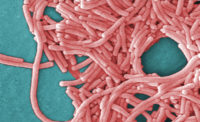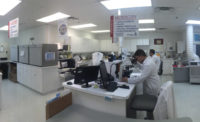A Legionnaires’ disease outbreak in New York City in the South Bronx has now sickened at least 127 people, and 12 people have died from the illness. Health officials said it’s the largest known outbreak in New York City.
According to the New York City Department of Health and Mental Hygiene, Legionnaires’ disease cases were first reported on July 10 in the South Bronx. By July 30, Mayor Bill de Blasio’s office reported 46 cases and two deaths.
City officials tested 17 cooling towers in the South Bronx and five were found to be contaminated with Legionella bacteria. The five locations were identified as the Concourse Plaza shopping center, Lincoln Hospital, Opera House Hotel, Streamline Plastic Co., and a Verizon office building. All five systems were disinfected.
City health officials stated they’re “confident that one or more of the five locations that tested positive was the source of the outbreak.” An epidemiological investigation is ongoing, and maintenance regulations have been implemented.
Since Legionnaires’ disease has an incubation period of up to 10 days, even though the suspected cooling towers were cleaned, the disease count continues to rise, and more cases may still be reported after this issue is printed.
WHAT IS LEGIONNAIRES’ DISEASE?
According to the Centers for Disease Control and Prevention (CDC), Legionnaires’ disease is a severe pneumonia caused by a type of bacteria called Legionella. (A milder, flu-like form of the disease is called Pontiac fever. The two illnesses are also referred to as legionellosis.) Death can occur in 5-30 percent of Legionnaires’ disease cases.
Legionella bacteria are found naturally in the environment, usually in water. These bacteria grow best in warm water. People can contract Legionnaires’ disease when they breathe in a mist containing the bacteria. The bacteria are not spread person-to-person.
Cooling towers are potential breeding grounds for Legionella bacteria if they’re not properly maintained. Water within cooling towers is heated via heat exchange, which is an ideal environment for the heat-loving bacteria to grow. Since heat and evaporated water are rejected out of the top of the tower in the form of a fine cloud-like mist, which can spread nearby, contaminated cooling towers can be a source of Legionnaires’ disease.
At a July 30 press conference, New York City health commissioner, Dr. Mary Basset, noted: “In the U.S., and in our city, the number of cases of Legionnaires’ disease has been increasing since the year 2000. The reasons for that are not clear, but may have to do with better case ascertainment. We have better lab tests that enable us to make the diagnosis. And it also may have to do with the fact that we have an aging population, causing more people to be susceptible to the infection.”
According to “Legionellosis on the Rise: A Review of Guidelines for Prevention in the United States,” published in the Journal of Public Health Management & Practice, reported cases of legionellosis more than tripled between 2001 and 2012 in the U.S.
By Aug. 2, it was announced that 71 people had been sickened in New York City and four were dead.
COOLING TOWERS MUST BE MAINTAINED
Matt Freije has specialized in Legionella prevention since founding San Diego-based HC Info in 1995. He’s written books, developed water management plan templates, taught seminars, and written and narrated e-learning courses. “Legionella bacteria need food and a proper environment for growth,” he said. “[They need] the right temperature, protection, and nutrients.”
He noted that cooling towers “must be properly treated and maintained to minimize Legionella.” As for recommended control measures, Freije said: “There are a number of specific measures. Most of them fall into one of four categories: cleaning, water treatment, minimizing stagnation, and routine inspections for proper operation of the cooling tower and water treatment system.”
BEST PRACTICES
Daniel T. Donnelly, CEO of Donnelly Mechanical, Queens Village, New York, a commercial HVAC and energy services contractor, stated that cooling tower problems can be avoided with “a regimented maintenance and water treatment program.”
Donnelly said that in performing maintenance, you need to look at the whole system, including the cooling tower, pumps, and automated controls. “In addition to that, you have a regular water treatment program.”
He recommends cooling towers “should at least be checked once a week. Someone should be physically examining it once a week.” He also recommends monthly maintenance, two tower cleanings a year (in the city he does not believe one cleaning is enough), and a comprehensive water treatment program.
Jim Cunningham, New York representative for Nu-Calgon Inc., St. Louis, a supplier of water treatment products, said: “Chemical preventive maintenance is the key to keeping a cooling tower system operating in a clean, safe, and efficient manner. There are many good products and companies available to accomplish this.
“Towers and associated piping and equipment should be physically and chemically cleaned of dirt, sediment, scale, and organic material. There should be an ongoing chemical treatment program using cooling tower biocides/algaecides to prevent all biological growths in the system water. This makes the system inhospitable to a wide range of biological activity, including Legionella. Monthly bacteria testing can be done to ensure control.”
Commenting on the frequency of monitoring, Freije said: “Some control measures should be performed daily and others weekly, monthly, or even less frequently. Chemical and microbial tests should be conducted per the water treatment vendor’s recommendations, but no less than any frequency recommended by the Cooling Technology Institute (CTI) or ASHRAE. Cooling towers should also be tested periodically for Legionella. In its new publication, “Recognition, Evaluation, and Control of Legionella in Building Water Systems,” the American Industrial Hygiene Association (AIHA) recommends monthly Legionella testing in cooling towers.”
Cunningham said: “For very large systems at hospitals and other commercial buildings, the cooling tower should be visually inspected every day by maintenance staff, and some water tests should be done every day to monitor conditions. Bacteria tests take time. For small- and medium-size cooling towers, a monthly inspection and test to confirm control
is recommended.”
Regarding how prevalent Legionella are in cooling towers, Cunningham said: “The prevalence of Legionella in cooling towers is unknown, since very few systems are ever tested specifically for Legionella. However, biological growths such as bacterial slimes and algae are fairly common in cooling tower systems. The presence of any biological growth is a signal that conditions are ripe for more biological growth, and the cooling tower needs to be cleaned and treated.
“Most large cooling tower systems have some kind of chemical water treatment program in place to prevent scale buildup, corrosion, and biological growths,” he noted. “An interruption of treatment or inadequate treatment could lead to an outbreak of biological growths.”
At a press briefing on Aug. 13, de Blasio stated there were no new cases of Legionnaires’ disease since Aug. 3. The number of cases continued to grow due to patient cases being “clarified or re-designated as Legionnaires.’”
Freije pointed out that ASHRAE’s new Legionella standard, ANSI/ASHRAE Standard 188-2015, “Legionellosis: Risk Management for Building Water Systems,” specifies the essential components of a water management plan. To comply with the standard, he said: “Building operators must implement a water management plan for cooling towers and other water systems that can harbor and transmit Legionella bacteria. HVAC contractors can play a role in the implementation of a water management plan by providing services related to cooling tower cleaning and maintenance.”
NEW LEGISLATION COMING
On Aug. 3, Mayor de Blasio said in a statement: “A more systemic solution is required to prevent the cycle of these outbreaks from continuing. This week, new legislation will be designed to halt future outbreaks of Legionnaires’ and place new emphasis on long-term prevention. The comprehensive package will address inspections, new recommended action in the case of positive tests, and sanctions for those who fail to comply with new standards.”
The mayor announced in a press conference on Aug. 4 that there were 86 cases of the disease reported and seven deaths. He emphasized, “We’ve been aggressively investigating and testing any and all possible sources of this outbreak.”
At a press conference on Aug. 6, Mayor de Blasio announced a total 100 cases and 10 deaths. He said the city was now issuing a health commissioner’s order that instructs the owners or managers of buildings with cooling towers “to test and disinfect their cooling tower within the next 14 days. Failure to comply with the commissioner’s order is a misdemeanor.”
Also on Aug. 6, New York Gov. Andrew Cuomo announced free Legionella testing for all cooling towers statewide.
Both the city and state are now on full alert, making a concerted effort to halt the outbreak.
On Aug. 7, Basset issued a statement saying: “We now see the frequency of diagnoses as well as the number of emergency department visits for pneumonia in the South Bronx decreasing. We have fewer new cases. People are seeking care and treatment promptly. We’re optimistic we’ve seen the worst of this outbreak and our remediation efforts are having an impact.”
She added, “We must all remain vigilant. The health department will continue to monitor for new cases and check that building owners are continuing remediation efforts.”
SIDEBAR: NEW YORK CITY IMPOSES COOLING TOWER REGULATIONS
On Aug. 10, Mayor Bill de Blasio and the New York City Council announced proposed legislation regulating cooling towers that the mayor said is the first in the nation requiring detailed oversight, including mandatory registration, testing and inspection, and sanctions for failure to comply.
The legislation, which was officially implemented Aug. 18, includes the following:
Registration and Certification
• Registration of existing cooling towers with the Department of Buildings (DOB) within 60 days of the law taking effect. Registration of new cooling towers prior to initial operation.
• Annual certification to the DOB by owners or operators that cooling towers have been inspected, tested, cleaned, and disinfected in accordance with New York City Department of Health and Mental Hygiene (DOHMH) regulations.
Maintenance, Inspection, and Testing
• Development of a maintenance program and plan that is in accordance with section 7.2 of ASHRAE’s Legionella standard.
• Inspection and testing of cooling towers on a quarterly basis when a building’s cooling tower is in use, and within 15 days before the initial use during any year. Inspections must include a test for the presence of microbes in the cooling tower water.
• Establishment of acceptable methods of testing and laboratory analysis by DOHMH rule, including acceptable methods of cleaning and disinfecting cooling towers.
Enforcement
• Failure to register or submit annual certification to the Department of Buildings will be a major violation, punishable by a penalty to be established by the DOB.
• The Health Department will inspect cooling towers and impose significant penalties for violations.
On Aug. 11, Gov. Andrew Cuomo and Mayor de Blasio announced the state and city would be jointly instituting uniform regulations to combat Legionnaires’ disease. The city legislation was passed by the New York City Council and adopted by the mayor Aug. 18. The governor may use his emergency powers to make the policy statewide.
UPDATE: On Aug. 20, Bassett announced, “After extensive review and coordination of laboratory data at the city, state, and federal levels, we have identified the source of the outbreak in the South Bronx — the Opera House Hotel’s cooling tower.” The Legionella strain found in that cooling tower matched the strain found in patients. The health department officially declared the outbreak over.
Publication date: 8/24/2015
Want more HVAC industry news and information? Join The NEWS on Facebook, Twitter, and LinkedIn today!








